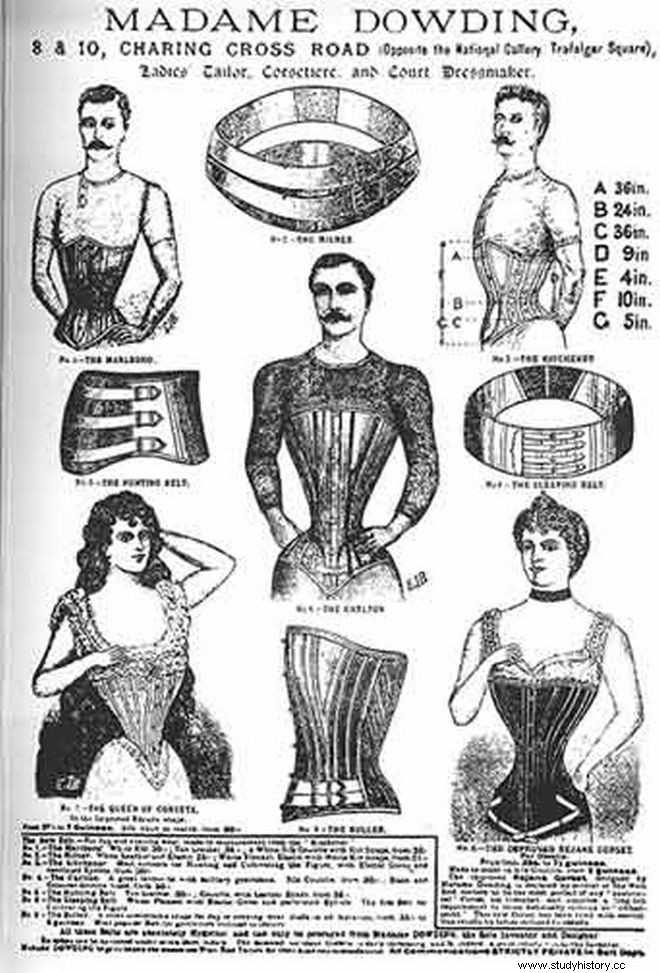In the fantastic times we live in, with the pandemic having challenged (to the point of 'shattering') what we knew as normal (or given), what Sotiris Tsiodras wore under his shirt became an issue and was revealed when he went to get the vaccine for Covid-19.
First of all, every self-respecting fashionista (that is, those who fell to 'eating' him) should know that the corset was in fashion last year as well, as Teen Vogue analyzed extensively. The corset (as it was called by those who 'removed' it, which were the French) is a garment created to hold the torso of the body in the 'desired' shape. That is, to reduce the waist and "support" the chest. That is, to create curves that made the upper half of the body refer to the letter 'S' (from the shoulders to the hips), the epitome of femininity at the time. This in regards to women.
Men wore it (in the 18th and 19th centuries) to 'collect' their upper body (with an emphasis on the abdomen), as then a small waist was a must for them too.
In general, keep in mind that the corset was used from the end of the 16th century until 1914 (the parts that 'gathered' were renewed - with the displacement at the hip) when 'women's bodies resembled telephone poles'.

Obviously, the pressure that lasted for hours also caused various health problems. The first was that it was "taking your breath away". The second is how the instruments were shifted. The third had to do with infertility, as chronic use led to the appearance of endometriosis (see the layer of tissue that under normal conditions covers the inside of the uterus -endometrium-, develops in another part of the body -such as the ovaries, fallopian tubes or elsewhere). Since the 20s, the straps have been loosened, literally and figuratively, with straight silhouettes (rather than 'S's') being the new trend.
How the word came about
The term 'corset' has its 'base' in 'cors' which is body in French. It comes from the Latin corpus. Actually, it's an understatement. Hence it means 'small body'. In 1828 the term began to be used outside France. For the first time it appeared in the British monthly magazine - about fashion - which had the title 'Ladies Magazine'. It was specified as 'the quilted waistcoat, which the French call a corset'.
Let's go now to the cache-corset.
According to the experts, the cache-corset was created for women to wear over the corset and under their dress, in order to protect the garment from rubbing against the underwear. It was made of cotton or linen and could have embroidery, lace and/or buttons.
When the planet was spared the need to suppress its vital organs and ribs, a corset was designated as what children with scoliosis - or other back support needs - wore. The sleeveless (with straps) undershirt for men, which touches the body and exposes the sternum, had already become a habit.
What you are saying is called a tank top in the US and Canada. Only in Greece do we call it 'cascorse', for some twisted reason that clearly has to do with one of the nation's basic principles, in which 'this is how we learned it, this is how we tell you' and it was justified before there was Internet - and therefore the providing information we have today.
So, an accurate expert could claim that Tsiodras was not wearing a cascorset. Of course, the use of the term 'tank top' would spoil the narrative of those who felt they had to comment on his shirt. Because you never know what dawns, keep what follows.
✎ In England, Scotland, Ireland, Australia, Ghana, Nigeria, Hong Kong, Singapore, New Zealand, Indonesia, part of Hawaii and the French-speaking part of Belgium it is called a 'singlet'.
✎ The 'headquarters' of the corset is called 'marcel', after Marcel Eisenberg, the first businessman to proceed with large-scale production of this type of clothing.
✎ In Russia it is known as mayka.
✎ In the Philippines they call it sando
✎ In most of India (where they wear it to absorb sweat and not 'come out' on blouses and shirts) it is called banian.
The most intriguing element regarding the tank top - which I will say again is not called a cascorset - is that for some years it was called 'wifebeater', on the other side of the Atlantic. It was worn by James Hartford Jr., who was arrested in 1947 for physically abusing his wife. In the photo published in the newspapers he appeared with a soiled undershirt. Since the term 'wifebeater' was not particularly positive, the tank top was preferred, with Marlon Brando doing the rest.

By the way, this was 'inspired' by Samuel T. Cooper, owner of a woolen hosiery business in Chicago, in January 1935. As Mel Magazine writes, until then men's underwear consisted of sports jerseys, leggings and one-piece overalls that covered him who wore them, from head to toe. Cooper gave the world the briefs (he called them jockeys) that supported and those that needed to be supported. In three months he had sold 30,000 pairs. Then he thought it would be useful to create something for the upper body as well, which would be light, sleeveless. He called it the A-shirt (the A from Athletic). Soon, brands like Hanes and Fruit of the Loom followed suit. Their main goal was to not let sweat show up on the clothes.
Read the News from Greece and the world, with the reliability and validity of News247.gr.
